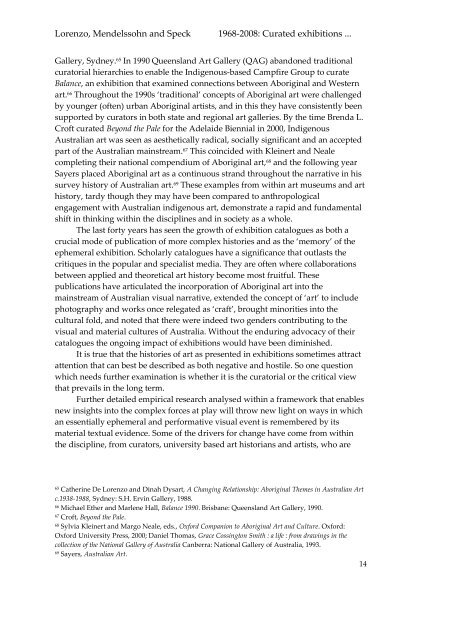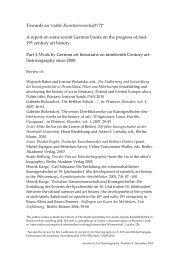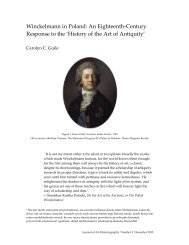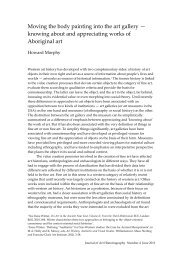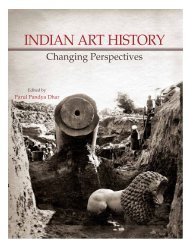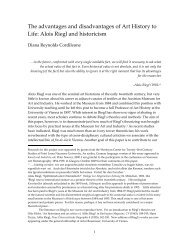Exhibitions as drivers for Australian art history - Journal of Art ...
Exhibitions as drivers for Australian art history - Journal of Art ...
Exhibitions as drivers for Australian art history - Journal of Art ...
You also want an ePaper? Increase the reach of your titles
YUMPU automatically turns print PDFs into web optimized ePapers that Google loves.
Lorenzo, Mendelssohn and Speck 1968-2008: Curated exhibitions ...<br />
Gallery, Sydney. 65 In 1990 Queensland <strong>Art</strong> Gallery (QAG) abandoned traditional<br />
curatorial hierarchies to enable the Indigenous-b<strong>as</strong>ed Campfire Group to curate<br />
Balance, an exhibition that examined connections between Aboriginal and Western<br />
<strong>art</strong>. 66 Throughout the 1990s ‘traditional’ concepts <strong>of</strong> Aboriginal <strong>art</strong> were challenged<br />
by younger (<strong>of</strong>ten) urban Aboriginal <strong>art</strong>ists, and in this they have consistently been<br />
supported by curators in both state and regional <strong>art</strong> galleries. By the time Brenda L.<br />
Cr<strong>of</strong>t curated Beyond the Pale <strong>for</strong> the Adelaide Biennial in 2000, Indigenous<br />
<strong>Australian</strong> <strong>art</strong> w<strong>as</strong> seen <strong>as</strong> aesthetically radical, socially significant and an accepted<br />
p<strong>art</strong> <strong>of</strong> the <strong>Australian</strong> mainstream. 67 This coincided with Kleinert and Neale<br />
completing their national compendium <strong>of</strong> Aboriginal <strong>art</strong>, 68 and the following year<br />
Sayers placed Aboriginal <strong>art</strong> <strong>as</strong> a continuous strand throughout the narrative in his<br />
survey <strong>history</strong> <strong>of</strong> <strong>Australian</strong> <strong>art</strong>. 69 These examples from within <strong>art</strong> museums and <strong>art</strong><br />
<strong>history</strong>, tardy though they may have been compared to anthropological<br />
engagement with <strong>Australian</strong> indigenous <strong>art</strong>, demonstrate a rapid and fundamental<br />
shift in thinking within the disciplines and in society <strong>as</strong> a whole.<br />
The l<strong>as</strong>t <strong>for</strong>ty years h<strong>as</strong> seen the growth <strong>of</strong> exhibition catalogues <strong>as</strong> both a<br />
crucial mode <strong>of</strong> publication <strong>of</strong> more complex histories and <strong>as</strong> the ‘memory’ <strong>of</strong> the<br />
ephemeral exhibition. Scholarly catalogues have a significance that outl<strong>as</strong>ts the<br />
critiques in the popular and specialist media. They are <strong>of</strong>ten where collaborations<br />
between applied and theoretical <strong>art</strong> <strong>history</strong> become most fruitful. These<br />
publications have <strong>art</strong>iculated the incorporation <strong>of</strong> Aboriginal <strong>art</strong> into the<br />
mainstream <strong>of</strong> <strong>Australian</strong> visual narrative, extended the concept <strong>of</strong> ‘<strong>art</strong>’ to include<br />
photography and works once relegated <strong>as</strong> ‘craft’, brought minorities into the<br />
cultural fold, and noted that there were indeed two genders contributing to the<br />
visual and material cultures <strong>of</strong> Australia. Without the enduring advocacy <strong>of</strong> their<br />
catalogues the ongoing impact <strong>of</strong> exhibitions would have been diminished.<br />
It is true that the histories <strong>of</strong> <strong>art</strong> <strong>as</strong> presented in exhibitions sometimes attract<br />
attention that can best be described <strong>as</strong> both negative and hostile. So one question<br />
which needs further examination is whether it is the curatorial or the critical view<br />
that prevails in the long term.<br />
Further detailed empirical research analysed within a framework that enables<br />
new insights into the complex <strong>for</strong>ces at play will throw new light on ways in which<br />
an essentially ephemeral and per<strong>for</strong>mative visual event is remembered by its<br />
material textual evidence. Some <strong>of</strong> the <strong>drivers</strong> <strong>for</strong> change have come from within<br />
the discipline, from curators, university b<strong>as</strong>ed <strong>art</strong> historians and <strong>art</strong>ists, who are<br />
65 Catherine De Lorenzo and Dinah Dys<strong>art</strong>, A Changing Relationship: Aboriginal Themes in <strong>Australian</strong> <strong>Art</strong><br />
c.1938-1988, Sydney: S.H. Ervin Gallery, 1988.<br />
66 Michael Ether and Marlene Hall, Balance 1990. Brisbane: Queensland <strong>Art</strong> Gallery, 1990.<br />
67 Cr<strong>of</strong>t, Beyond the Pale.<br />
68 Sylvia Kleinert and Margo Neale, eds., Ox<strong>for</strong>d Companion to Aboriginal <strong>Art</strong> and Culture. Ox<strong>for</strong>d:<br />
Ox<strong>for</strong>d University Press, 2000; Daniel Thom<strong>as</strong>, Grace Cossington Smith : a life : from drawings in the<br />
collection <strong>of</strong> the National Gallery <strong>of</strong> Australia Canberra: National Gallery <strong>of</strong> Australia, 1993.<br />
69 Sayers, <strong>Australian</strong> <strong>Art</strong>.<br />
14


